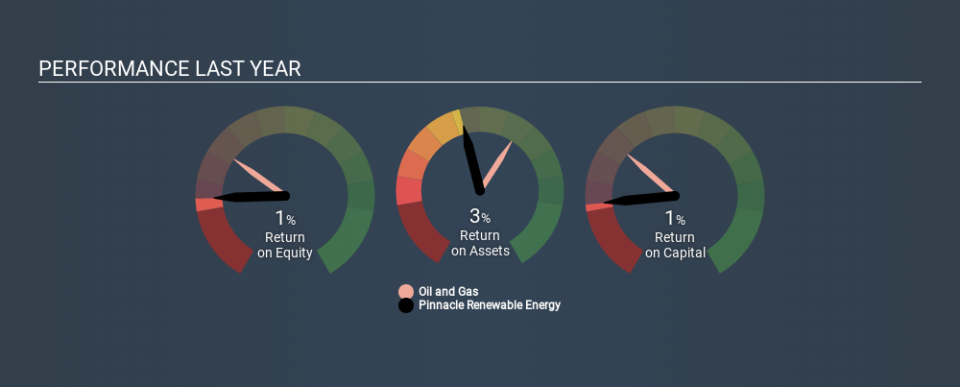Examining Pinnacle Renewable Energy Inc.’s (TSE:PL) Weak Return On Capital Employed

Today we are going to look at Pinnacle Renewable Energy Inc. (TSE:PL) to see whether it might be an attractive investment prospect. In particular, we'll consider its Return On Capital Employed (ROCE), as that can give us insight into how profitably the company is able to employ capital in its business.
First of all, we'll work out how to calculate ROCE. Second, we'll look at its ROCE compared to similar companies. And finally, we'll look at how its current liabilities are impacting its ROCE.
What is Return On Capital Employed (ROCE)?
ROCE measures the 'return' (pre-tax profit) a company generates from capital employed in its business. Generally speaking a higher ROCE is better. Overall, it is a valuable metric that has its flaws. Renowned investment researcher Michael Mauboussin has suggested that a high ROCE can indicate that 'one dollar invested in the company generates value of more than one dollar'.
So, How Do We Calculate ROCE?
Analysts use this formula to calculate return on capital employed:
Return on Capital Employed = Earnings Before Interest and Tax (EBIT) ÷ (Total Assets - Current Liabilities)
Or for Pinnacle Renewable Energy:
0.0053 = CA$2.8m ÷ (CA$602m - CA$78m) (Based on the trailing twelve months to September 2019.)
Therefore, Pinnacle Renewable Energy has an ROCE of 0.5%.
Check out our latest analysis for Pinnacle Renewable Energy
Is Pinnacle Renewable Energy's ROCE Good?
ROCE is commonly used for comparing the performance of similar businesses. Using our data, Pinnacle Renewable Energy's ROCE appears to be significantly below the 5.4% average in the Oil and Gas industry. This performance could be negative if sustained, as it suggests the business may underperform its industry. Independently of how Pinnacle Renewable Energy compares to its industry, its ROCE in absolute terms is low; especially compared to the ~1.4% available in government bonds. There are potentially more appealing investments elsewhere.
Pinnacle Renewable Energy's current ROCE of 0.5% is lower than 3 years ago, when the company reported a 6.1% ROCE. So investors might consider if it has had issues recently. You can see in the image below how Pinnacle Renewable Energy's ROCE compares to its industry. Click to see more on past growth.
When considering ROCE, bear in mind that it reflects the past and does not necessarily predict the future. ROCE can be deceptive for cyclical businesses, as returns can look incredible in boom times, and terribly low in downturns. This is because ROCE only looks at one year, instead of considering returns across a whole cycle. Given the industry it operates in, Pinnacle Renewable Energy could be considered cyclical. What happens in the future is pretty important for investors, so we have prepared a free report on analyst forecasts for Pinnacle Renewable Energy.
What Are Current Liabilities, And How Do They Affect Pinnacle Renewable Energy's ROCE?
Current liabilities are short term bills and invoices that need to be paid in 12 months or less. Due to the way the ROCE equation works, having large bills due in the near term can make it look as though a company has less capital employed, and thus a higher ROCE than usual. To check the impact of this, we calculate if a company has high current liabilities relative to its total assets.
Pinnacle Renewable Energy has total assets of CA$602m and current liabilities of CA$78m. As a result, its current liabilities are equal to approximately 13% of its total assets. This is a modest level of current liabilities, which will have a limited impact on the ROCE.
The Bottom Line On Pinnacle Renewable Energy's ROCE
While that is good to see, Pinnacle Renewable Energy has a low ROCE and does not look attractive in this analysis. But note: make sure you look for a great company, not just the first idea you come across. So take a peek at this free list of interesting companies with strong recent earnings growth (and a P/E ratio below 20).
If you are like me, then you will not want to miss this free list of growing companies that insiders are buying.
If you spot an error that warrants correction, please contact the editor at editorial-team@simplywallst.com. This article by Simply Wall St is general in nature. It does not constitute a recommendation to buy or sell any stock, and does not take account of your objectives, or your financial situation. Simply Wall St has no position in the stocks mentioned.
We aim to bring you long-term focused research analysis driven by fundamental data. Note that our analysis may not factor in the latest price-sensitive company announcements or qualitative material. Thank you for reading.

 Yahoo Finance
Yahoo Finance 
